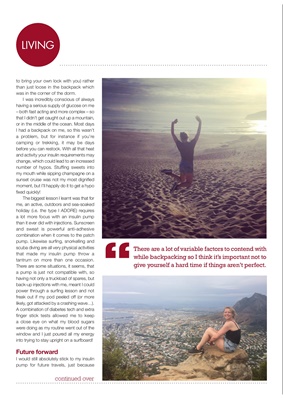
LIVINGLIVINGcontinued over
There are a lot of variable factors to contend with
while backpacking so I think it's important not to
give yourself a hard time if things aren't perfect.
to bring your own lock with you) rather
than just loose in the backpack which
was in the corner of the dorm.
I was incredibly conscious of always
having a serious supply of glucose on me
- both fast acting and more complex - so
that I didn't get caught out up a mountain,
or in the middle of the ocean. Most days
I had a backpack on me, so this wasn't
a problem, but for instance if you're
camping or trekking, it may be days
before you can restock. With all that heat
and activity your insulin requirements may
change, which could lead to an increased
number of hypos. Stuffing sweets into
my mouth while sipping champagne on a
sunset cruise was not my most dignified
moment, but I'll happily do it to get a hypo
fixed quickly!
The biggest lesson I learnt was that for
me, an active, outdoors and sea-soaked
holiday (i.e. the type I ADORE) requires
a lot more focus with an insulin pump
than it ever did with injections. Sunscreen
and sweat is powerful anti-adhesive
combination when it comes to the patch
pump. Likewise surfing, snorkelling and
scuba diving are all very physical activities
that made my insulin pump throw a
tantrum on more than one occasion.
There are some situations, it seems, that
a pump is just not compatible with, so
having not only a truckload of spares, but
back-up injections with me, meant I could
power through a surfing lesson and not
freak out if my pod peeled off (or more
likely, got attacked by a crashing wave…).
A combination of diabetes tech and extra
finger stick tests allowed me to keep
a close eye on what my blood sugars
were doing as my routine went out of the
window and I just poured all my energy
into trying to stay upright on a surfboard!
Future forward
I would still absolutely stick to my insulin
pump for future travels, just because "